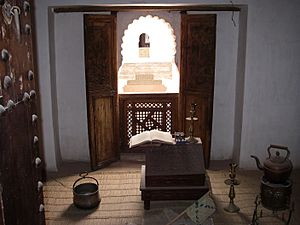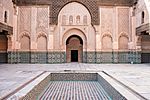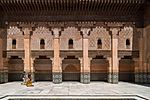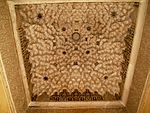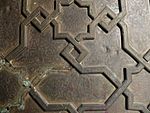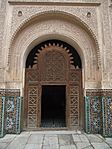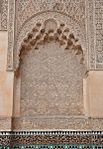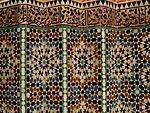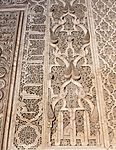Ben Youssef Madrasa facts for kids
Quick facts for kids Ben Youssef Madrasa |
|
|---|---|
|
مدرسة ابن يوسف
|
|
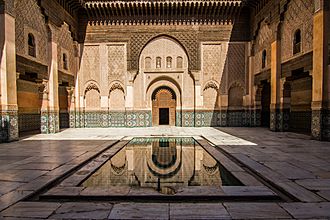
The main courtyard of the madrasa and its reflective pool
|
|
| General information | |
| Type | madrasa |
| Architectural style | Saadian, Moorish/Moroccan |
| Location | Marrakesh, Morocco |
| Coordinates | 31°37′55″N 7°59′10.3″W / 31.63194°N 7.986194°W |
| Completed | 1564–65 |
| Dimensions | |
| Other dimensions | 40 m × 43 m (131 ft × 141 ft) |
| Technical details | |
| Material | cedar wood, brick, stucco, tile |
| Floor count | 2 |
The Ben Youssef Madrasa (Arabic: مدرسة ابن يوسف) is an old Islamic school or college in Marrakesh, Morocco. A "madrasa" is a place where students learn about Islamic studies and other subjects. This madrasa was once the biggest Islamic college in the Maghreb region (North Africa). It is named after the nearby Ben Youssef Mosque, which was built by Sultan Ali ibn Yusuf a long time ago. The madrasa you see today was built later by Sultan Abdallah al-Ghalib in the 16th century. Today, it is a popular historical site that many tourists visit.
Contents
Discovering the History of Ben Youssef Madrasa
The Ben Youssef Madrasa gets its name from the Ben Youssef Mosque next to it. This mosque was once the main mosque of Marrakesh. It was founded by Sultan Ali ibn Yusuf in the early 1100s.
Some historical records say that the first madrasa on this spot was built by Sultan Abu al-Hasan in the 1300s. His dynasty, the Marinid dynasty, was famous for supporting arts and learning. They built many madrasas across Morocco. These schools taught ulama (Islamic scholars) about Islamic law and the Qur'an.
Later, the Saadian dynasty came to power. They also built many new buildings in Marrakesh, their capital city. The Ben Youssef Madrasa we see today was built by the Saadian Sultan Abdallah al-Ghalib. He was a big builder of his time. Construction likely started soon after he became sultan. It was finished in 1564–1565 AD.
Once it was built, it became the largest madrasa in the Maghreb. It could hold more than 800 students! The madrasa closed in 1960. But it was fixed up and reopened to the public in 1982. It closed again for more repairs in 2018 and opened its doors once more in April 2022. It is still one of the most important historical buildings in Marrakesh.
Exploring the Architecture of the Madrasa
Layout and Design of the Building
The madrasa is almost square, about 40 by 43 meters in size. You enter through a single doorway from the street. This entrance has a cool, carved ceiling called a muqarnas. A narrow hallway leads to a main room, which then opens into the central courtyard. This design makes you feel surprised and amazed when you step into the open courtyard.
The whole building is built around this main courtyard. The courtyard has long walkways on the east and west sides. Student dorm rooms are on both the upper and lower floors around it. In the middle of the courtyard is a large, shallow pool of water, about 3 by 7 meters. At one end of the courtyard, there's a large prayer hall. It has a special niche called a mihrab, which shows the direction of prayer. This mihrab is beautifully decorated with carved stucco.
The student rooms are grouped around the central courtyard. There are 130 student rooms in total. They are also arranged around six smaller courtyards. These smaller courtyards are found in the northeast and southwest parts of the building. This design allowed the madrasa to house up to 800 students, making it the biggest madrasa in Morocco.
On the ground floor, there is also a special room for washing. This room has four marble columns and a central dome. In the middle of this room is a square water basin. There are also small latrine rooms around the edge. An interesting fact is that an old marble basin from the 11th century was found in this washing room.
Beautiful Decorations and Art
The Ben Youssef Madrasa is known for its amazing decorations. It uses elements from old Moroccan and Andalusi buildings. These include pools, gardens, fountains, and surfaces covered in zellij (colorful mosaic tilework). You'll also see detailed carved stucco and wood.
The decorations follow a traditional style. The lower parts of the walls have zellij tiles. At eye-level, you'll find beautiful writing (calligraphy). The middle and upper parts of the walls are covered in stucco carvings. Then, they change to wooden parts, like fancy carved eaves. The main courtyard is especially stunning with all these decorations arranged in a balanced way.
The entrance to the central courtyard has a wooden screen called a mashrabiyya. It's under a grand archway decorated with carved stucco. While the student rooms are simple, the smaller courtyards leading to them have some stucco and wood decorations. The carvings on the wood and stucco show traditional designs. These include arabesques (swirling plant patterns), sebka (a net-like pattern), Arabic writing, and muqarnas (honeycomb-like carvings). You can also spot unique Saadian-era designs, like pine cones.
The street entrance has an amazing muqarnas vault. Another muqarnas dome is in the washing room. The madrasa's doors are covered with bronze plates that form cool geometric designs. The wooden beam above the doors has Arabic writing carved into it. This writing praises Sultan Abdallah as the builder of the madrasa. You can find many other writings throughout the building, often Qur'anic verses.
-
Example of a carved cedar wood ceiling with geometric star patterns
-
Zellij mosaic tilework in the madrasa
-
Arabesque and pine cone designs with Kufic writing around the mihrab
The Ancient Andalusi Marble Basin
Today, you can see a beautifully carved marble basin at the madrasa. This basin came from the Caliphate era in Cordoba, Spain. It was made between 1002 and 1007. It was used for washing before prayer.
This basin was kept at the Ben Youssef Madrasa for hundreds of years. Experts first noticed it in 1923. Some historians believe it was brought to Marrakesh by Sultan Ali Ibn Yusuf. He used marble pieces from old palaces in Cordoba for the Ben Youssef Mosque he built. The basin was then reused for the Ben Youssef Madrasa. For a while, it was kept at the Dar Si Said Museum. But after the madrasa was recently restored, the basin was moved back. Now, it is on display in the prayer hall of the madrasa.
See also
 In Spanish: Madrasa de Ben Youssef para niños
In Spanish: Madrasa de Ben Youssef para niños
- Bou Inania Madrasa in Fes
- Bou Inania Madrasa (Meknes)
- Shrob ou shouf fountain
- El Badi Palace
- Saadian Tombs


